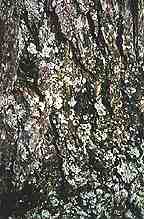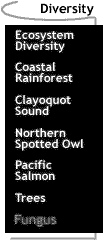Diversity: Fungus
 Douglas Fir Root Rot Caused by a Fungus
Douglas Fir Root Rot Caused by a Fungus
Once harvesting is completed on sites where the fungus is most rampant, the Oregon
Department of Forestry is fighting one facet of nature by using another: they are
introducing diversity to limit the spread of disease. They are planting alder, bigleaf
maple, and redcedar in two- to five-acre patches to thwart the continuing encroachment of
root rot by breaking up access to its preferred host, the Douglas-fir. In nature such a
mix of species is inherent, a guard against runaway infestations. © 1996. Durbin, K. Oregon. In R. Kirk (Ed.), The Enduring Forests.
Seattle: The Mountaineers, p. 55. Photo: Courtesy of Steven K. Croft.
The Role of Fungus in the Forest
Fungi fill many roles. They act as decomposers, cause disease, and live inside foliage,
producing chemicals distasteful to insects. Thousands combine with algae to form lichens.
Still others, ... fuse with tree roots in a partnership that benefits both the tree and
the fungus. © 1996. McNulty, T. Washington.
In R. Kirk (Ed.), The Enduring Forests. Seattle: The Mountaineers, p. 99.
Truffles are the spore-laden fruit of below-ground fungi, many of which form
mycorrhizal relationships with tree roots. Mycorrhiza means literally
"fungus-root" and refers to a symbiotic association in which threadlike mycelia
grow on or within root tissues and crucially enhance their absorption of moisture and
nutrients from the soil. The fungi stimulate root growth and also deter soil-borne
pathogens and root-grazers. In turn, trees pass photosynthates - sugars and amino acids -
through their roots to the fungi, which cannot produce food for themselves. These
elaborate underground networks even transfer carbon and nutrients from tree to tree,
enabling shade-bound trees to benefit from the photosynthesis if neighbors that have
succeeded in reaching the canopy above. Some 60 percent of the carbon produced by
photosynthesis actually goes to roots and mycorrhizae within the soil. This symbiosis begs
the question of individual organisms living independently and points instead to the unity
of the forest ecosystem. © 1996. McNulty, T.
Washington. In R. Kirk (Ed.), The Enduring Forests. Seattle: The Mountaineers, p.
90.



